
Carmel-by-the-Sea, commonly known simply as Carmel, is a city in Monterey County, California, located on the Central Coast of California. As of the 2020 census, the town had a total population of 3,220, down from 3,722 at the 2010 census. Situated on the Monterey Peninsula, Carmel is a popular tourist destination, known for its natural scenery and rich artistic history.

A statue of Junípero Serra, also known as the Serra Shrine, was installed in the community of Carmel Woods in Carmel-by-the-Sea, California, United States. Artist Joseph "Jo" Mora (1876-1947), designed and carved the wood statue of Father Serra for real estate developer Samuel F.B. Morse's new subdivision.

Michael James Murphy was an American master builder in the Carmel-by-the-Sea, California. He had a significant influence on the character and architecture of the Village of Carmel. From 1902 to 1940, he built most of the early houses in Carmel, nearly 350 buildings. He erected the first house in Pebble Beach and also in the Carmel Highlands. He founded M. J. Murphy, Inc., which continues to supply building material for the Monterey Peninsula.

Thomas Albert Work was an American businessman and banker of Pacific Grove, California, known around Monterey as T. A. Work. He was owner of the T. A. Work company that made him the single largest business property owner on the Monterey Peninsula. He owned several banks, including the First National Bank of Monterey, Bank of Pacific Grove, Salinas, and the Bank of Carmel.

Outlands in the Eighty Acres, also known as Flanders Mansion is an 8,000-square-foot Tudor Revival house. It is significant as a work of architect Henry Higby Gutterson and for its innovative construction with light grey interlocking Precast concrete blocks. The mansion is preserved within the Mission Trail Nature Preserve in Carmel-by-the-Sea, California. It was listed on the National Register of Historic Places on March 23, 1989.

James Franklin Devendorf, was a pioneer real estate developer and philanthropist. Devendorf and attorney Frank Hubbard Powers (1864-1921), founded the Carmel Development Company in 1902. He became the "Father" of an artists and writers' colony that became Carmel-by-the-Sea, California, which included the Carmel Highlands, California. Devendorf spent the next 30 years of his life developing Carmel and the Carmel Highlands into a community of painters, writers, and musicians.

Frank Hubbard Powers, served in the California State Assembly for the 41st district from 1895 to 1897. He was a San Francisco attorney for Heller & Powers. He and real estate developer James Franklin Devendorf (1856-1934), founded the Carmel Development Company in 1902. They established an art colony that became Carmel-by-the-Sea, California, which included the Carmel Highlands, California.

Santiago Jacob Duckworth, known locally as S. J. Duckworth, served in the California State Assembly for the 61st district from 1893 to 1895. He was as an early Monterey pioneer businessman, real estate developer, and visionary of the short-lived Carmel City. In 1889, he wanted to build a Catholic summer resort, bought the rights to develop the area, filed a subdivision map, and started selling lots. After an unsuccessful undertaking, he sold the property to James Franklin Devendorf in 1902, who went on to found the Carmel Development Company and Carmel-by-the-Sea, and the Carmel Highlands in California, United States. Duckworth helped shape the early development of Carmel, bringing the first major developers and builders, and attracting some of the first residents.

Honoré Escolle, was as a French businessman from Monterey, California. He was an early pioneer who became a significant landholder in Monterey County. In 1878, he purchased 1,400 unsettled acres (570 ha) acres of the Sanchez's ranch near Gonzales, California. In the late 1880s, he sold 324 barren acres (131 ha) to Santiago J. Duckworth to build a Catholic Summer resort. This land later became Carmel-by-the-Sea, California
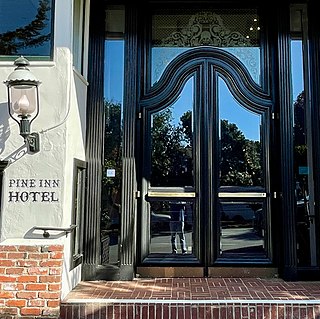
Pine Inn, once called the Hotel Carmelo, is one of the early first-class Arts and Crafts, Tudor, Spanish style hotels established in Carmel-by-the-Sea, California. The Pine Inn is a historical resource dating back to 1889 when pioneer Santiago J. Duckworth built Hotel Carmelo. James Franklin Devendorf, renamed the hotel the "Pine Inn" in 1904. Today, it is a full-service hotel. The Pine Inn qualified for inclusion in the city's Downtown Historic District Property Survey, and was registered with the California Register of Historical Resources on March 18, 2003. The Inn is significant under the California Register criterion 1, as the first hotel in the history of the downtown district of Carmel-by-the-Sea.
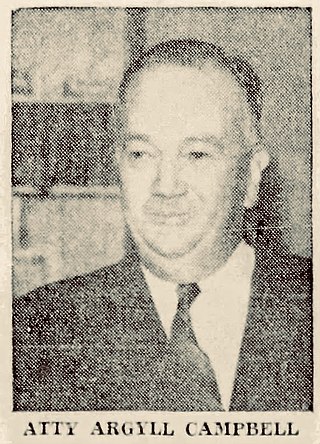
Argyll Campbell was city attorney for Carmel-by-the-Sea, California from 1920 to 1937. He was former chairman of the California Democratic Party to elect governor Culbert Olson. Campbell was a leader in Monterey Peninsula civic life for twenty-eight years. He was known for his efforts to "keep Carmel from radical change."
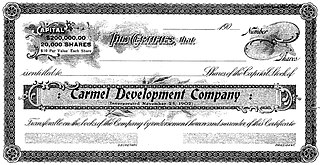
The Carmel Development Company was a real-estate development company that operated in Carmel-by-the-Sea, California from 1902 to 1965. It was developed by James Franklin Devendorf and Frank Hubbard Powers in 1902. Powers provided the capital and did the legal work of the corporation. Devendorf was the general manager and oversaw subdividing and developing the land. Between 1900 and 1910 the Carmel Development Company purchased parcels of land.

T.A. Oakes Building, is a historic commercial building in Carmel-by-the-Sea, California. It was built in 1922, by builder Thomas A. Oakes and designed by architect Thomas W. Morgan for a new Post Office and City Hall. It is an example of Western false front and Spanish Colonial Revival architecture styles. The building qualifies as an important building in the city's downtown historic district property survey and was recorded with the California Register of Historical Resources on October 28, 2002.
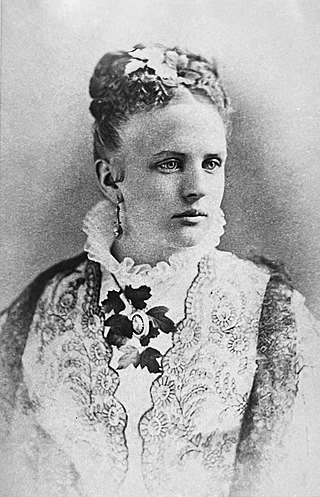
Abigail Jane Hunter, (1855–???) was as an early pioneer businesswoman, real estate developer, and visionary of Carmel-by-the-Sea. She is best known as Carmel's first woman real estate developer and important contributor in Carmel's early years. In 1889, she worked with Santiago James Duckworth to help build a Catholic summer resort called Carmel City. Hunter is credited with coining the name Carmel-by-the-Sea and utilizing it in promoting Carmel City through newspaper advertisements and postcard mailers. After an unsuccessful undertaking, she sold her Carmel holdings in 1900.

Carmel Point also known as the Point and formerly called Point Loeb and Reamer's Point, is an unincorporated community in Monterey County, California, United States. It is a cape located at the southern city limits of Carmel-by-the-Sea and offers views of Carmel Bay, the mouth of Carmel River, and Point Lobos. Carmel Point was one of three major land developments adjacent to the Carmel city limits between 1922 and 1925. The other two were Hatton Fields, 233 acres (94 ha) between the eastern town limit and Highway 1, and Carmel Woods, 125 acres (51 ha) tract on the north side.

Joseph W. Hand, was an early pioneer businessman, real estate agent, leader in civic affairs, actor, and first president of the Forest Theater in Carmel-by-the-Sea.

Frederick Ritchie Bechdolt was an American journalist, Western fiction writer, and pioneer member of the Carmel art colony. He is best known as a Western writer for the works When the West Was Young, and in collaboration with James Hopper on fictional novel 9009. He wrote for the newspapers The Seattle Star, and the Los Angeles Times.
Percy Parkes was an American master builder in Carmel-by-the-Sea, California. Parkes was one of the main progressive builders in Monterey County through the 1920s and 1930s, and the first contractor to build homes on Scenic Drive. His best known commercial buildings are the Seven Arts Building (1928), the Dummage Building (1924), and the Percy Parkes Building (1926). His American Craftsman-style, influenced by the Arts and Crafts movement, is evident in the buildings he constructed during that time.
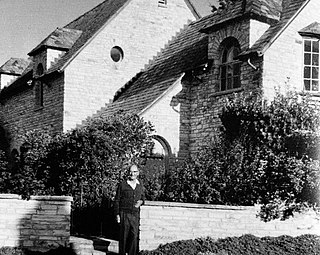
Ernest Samuel Bixler was an American master builder and designer in Carmel-by-the-Sea, California. From the 1930s to 1950s, he built over 80 homes in the Carmel area, three on Scenic Road. He served as postmaster and was a member of the Carmel Planning Commission. Bixler became known for building Spanish Eclectic-style homes.
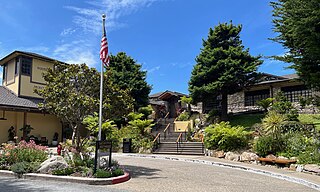
Highlands Inn is a historic resort hotel located in Carmel Highlands, California. Constructed in 1917 by Frank Devendorf, one of the early co-founders of Carmel-by-the-Sea and a real estate developer, the inn was built on land acquired in 1906 from local ranchers, south of Point Lobos. This establishment is part of the Hyatt Hotels Corporation.


























